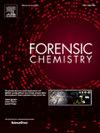Detection and quantitation of the semi-synthetic cannabinoid hexahydrocannabinol in seized samples from Scottish prisons
IF 2.6
3区 医学
Q2 CHEMISTRY, ANALYTICAL
引用次数: 0
Abstract
The dynamic new psychoactive substance market is constantly evolving and adapting as new legislative regulations are established. The prevalence of new psychoactive substances within the Scottish prison Service has been well documented, with this unique illicit drug ecosystem facilitating the detection of compounds often preceding their identification in forensic toxicology samples. This study provides an overview of two case samples seized from Scottish prisons between November 2023 and April 2024, where the semi-synthetic cannabinoid, hexahydrocannabinol, was identified following a quantitative gas chromatography-mass spectrometry (GC–MS) analysis. This semi-synthetic cannabinoid was detected alongside other traditional cannabinoids including cannabidiol, cannabinol, Δ9-tetrahydrocannabinol, and Δ8-tetrahydrocannabinol. Variability of the ratio between hexahydrocannabinol isomers was observed in the samples, as well as variability in the concentrations of other cannabinoids. This highlights the importance of quantitative analysis, as distinct effects can be expected from the variable sample compositions. In conclusion, this study marks the first detections of the semi-synthetic cannabinoid, hexahydrocannabinol, within the Scottish prison estate, demonstrating its emergence within that illicit drug market.

在苏格兰监狱检获的样本中检测及定量半合成大麻素六氢大麻酚
随着新的立法法规的建立,动态的新型精神活性物质市场不断发展和适应。新的精神活性物质在苏格兰监狱系统内的普遍存在已得到充分的记录,这种独特的非法药物生态系统有助于在法医毒理学样本中识别化合物之前对其进行检测。本研究概述了2023年11月至2024年4月期间从苏格兰监狱查获的两个案例样本,其中通过定量气相色谱-质谱(GC-MS)分析确定了半合成大麻素六氢大麻酚。这种半合成大麻素与其他传统大麻素一起被检测到,包括大麻二酚、大麻酚Δ9-tetrahydrocannabinol和Δ8-tetrahydrocannabinol。在样品中观察到六氢大麻酚异构体之间比例的可变性,以及其他大麻素浓度的可变性。这突出了定量分析的重要性,因为可以从可变的样品组成中预期不同的效果。总之,这项研究标志着在苏格兰监狱内首次检测到半合成大麻素六氢大麻酚,表明其出现在非法毒品市场中。
本文章由计算机程序翻译,如有差异,请以英文原文为准。
求助全文
约1分钟内获得全文
求助全文
来源期刊

Forensic Chemistry
CHEMISTRY, ANALYTICAL-
CiteScore
5.70
自引率
14.80%
发文量
65
审稿时长
46 days
期刊介绍:
Forensic Chemistry publishes high quality manuscripts focusing on the theory, research and application of any chemical science to forensic analysis. The scope of the journal includes fundamental advancements that result in a better understanding of the evidentiary significance derived from the physical and chemical analysis of materials. The scope of Forensic Chemistry will also include the application and or development of any molecular and atomic spectrochemical technique, electrochemical techniques, sensors, surface characterization techniques, mass spectrometry, nuclear magnetic resonance, chemometrics and statistics, and separation sciences (e.g. chromatography) that provide insight into the forensic analysis of materials. Evidential topics of interest to the journal include, but are not limited to, fingerprint analysis, drug analysis, ignitable liquid residue analysis, explosives detection and analysis, the characterization and comparison of trace evidence (glass, fibers, paints and polymers, tapes, soils and other materials), ink and paper analysis, gunshot residue analysis, synthetic pathways for drugs, toxicology and the analysis and chemistry associated with the components of fingermarks. The journal is particularly interested in receiving manuscripts that report advances in the forensic interpretation of chemical evidence. Technology Readiness Level: When submitting an article to Forensic Chemistry, all authors will be asked to self-assign a Technology Readiness Level (TRL) to their article. The purpose of the TRL system is to help readers understand the level of maturity of an idea or method, to help track the evolution of readiness of a given technique or method, and to help filter published articles by the expected ease of implementation in an operation setting within a crime lab.
 求助内容:
求助内容: 应助结果提醒方式:
应助结果提醒方式:


